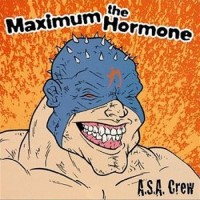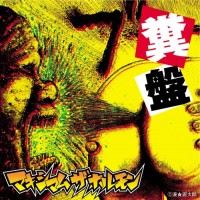Getting Into: Maximum The Hormone

| Written by: | ScreamingSteelUS |
| Published: | November 29, 2016 |
The articles in this series begun by our own Baz Anderson are designed to give a brief overview of a band's entire discography, so as to provide a clear point of entry for the uninitiated. It offers a different approach from the typical review format, for the curious newcomer to a well-traveled band.
Maximum The Hormone
Hardcore, alternative metal, nu metal, J-rock, punk
Japan
Maximum The Hormone is a band of contrasts: jovial pop-punk choruses and screeching, metallic verses; groovy, percussive beatdowns and free-spirited rock'n'roll sing-alongs; crude, colorful humor and periodic forays into a dark, desperate undercurrent. With a versatile, three-pronged vocal apparatus, an electrifying and outspoken rhythm section, and the songwriting expertise and attention to detail necessary to utilize the band's prodigious talents, Maximum The Hormone has evolved over the years so as to be unrecognizable from its original incarnation. Founded in 1998 by drummer Nao Kawakita and vocalist Daisuke Tsuda, Maximum The Hormone originated as merely a quirky hardcore punk band; it is in this guise that the band, rounded out by bassist Key and guitarist Sugi, released its debut, A.S.A. Crew. Shortly afterwards, the latter two members departed, to be replaced by bassist Futoshi Uehara and guitarist/clean vocalist Ryo Kawakita, Nao's younger brother. Under Ryo's aegis, the band evolved into an unpredictable behemoth characterized by chameleonic style shifts and uncommonly memorable songwriting. It would be safe to say that Maximum The Hormone is primarily known in the West for providing the opening and ending themes for the 2006 anime Death Note, namely "What's Up, People?!" and "Zetsubou Billy," both featured on the band's 2007 album Buiikikaesu, but there is a lot more to the band's career and signature style.
--
    | A.S.A. Crew (1999) Unsurprisingly, Maximum The Hormone's debut is the band's most straightforward release to date, following standard hardcore blueprints through a majority of the track list. The album does dabble in funk, ska, and thrash, longtime neighbors of punk, but most of these songs are rather less interesting, polished, catchy, and/or experimental than what most fans are no doubt used to. Daisuke's vocals are amateurish, devoid of technique and very far removed from his later distinctive style; his gravelly grunting and occasional stabs at clean singing suit the harsh bludgeoning of A.S.A. Crew, but the album does suffer with his and Nao's talents largely untapped and a complete lack of Ryo's now-irreplaceable cleans. A.S.A. Crew is enjoyable for anyone who appreciates loud, raw hardcore punk, but it is a very different beast from what Maximum The Hormone would grow into. Standout Tracks: "Purple Fire Tail," "Shine," "Kipo#40" |
| Mimi Kajiru (2002) The first album to feature Maximum The Hormone's current lineup clocks in at a scant 22 minutes (20 without bonus tracks), but Mimi Kajiru has a confidence that belies the insubstantial track lengths and shortcomings in production. The addition of bassist Uehara exponentially increases the force behind the band's rhythm section, bringing both the funk ("Nigire Tsutsu!!") and the pain ("Ningen Enpi"). New guitarist and vocalist Ryo also introduces a much more melodically-inclined songwriting mentality that manifests itself in songs like "Johnny Tetsu Pipe" and "Usugimi Billy" and would only develop further with the band's career. Though a short and simple offering, and still hosting a rather primitive version of the Maximum The Hormone to be, Mimi Kajiru is a very charming punk album with some unexpectedly memorable and crushing turns. Standout Tracks: "Ningen Enpi/人間エンピ," "Nigire Tsutsu!!/握れっっ!!", "Abara Bob/アバラ・ボブ" |      |
     | Kusoban (2004) Kusoban's running time falls behind even Mimi Kajiru, but the few songs are more focused and less cautious about straying beyond familiar realms. This album is the most polished of the band's early discography, but in outgrowing slipshod production and unsteady vocal performances, Maximum The Hormone also shed some of the violent bursts of energy and hardcore punk attitude that made A.S.A. Crew and Mimi Kajiru both exciting and charming. Even so, Kusoban's half-dozen punk songs are warm, friendly fun and exhibit the band's true spirit emerging from its cocoon, and though the songwriting isn't quite up to the level of successor albums, tracks like "Mr. Boogie Tambourine Man" and "Heisei Strawberry Vibe" rank among MTH's best. Standout Tracks: "Mr. Boogie Tambourine Man/Mrブギータンブリンマン," "Heisei Strawberry Vibe/平成ストロベリーバイブ," "Cefiro Radio Comeback ~Seishun Saikai~/セフィーロ・レディオ・カムバック ~青春最下位~" |
| Rokkinpo Goroshi (2005) Rokkinpo Goroshi is the first Maximum The Hormone album on which all three lead vocalists sound fully confident and capable, finally coming into their own as the unique and multifaceted assault team that helps define the band's sound. The production, too, finally reached a professional level, and with a much stronger sense of identity, Maximum The Hormone sounds in every way like a unique, established band on this album. It's no small wonder, then, that Rokkinpo Goroshi gained the band its first widespread exposure, riding on the success of a solid bevy of singles and an ear-catching System Of A Down-plays-anime-pop-punk-with-Flea-on-bass style. Rokkinpo Goroshi occasionally slows into more moderate tempos, even breaking down brutally in a few cases, twisting Maximum The Hormone's ska-punk heart into a crustier alt metal shell; even so, this is recognizably the band that crafted Kusoban and Mimi Kajiru, just better than ever. Standout Tracks: "Rei Rei Rei Rei Rei Rei Rei Rei Ma Ma Ma Ma Ma Ma Ma Ma/霊霊霊霊霊霊霊霊魔魔魔魔魔魔魔魔," "Nitro BB Sensō/ニトロBB戦争," "Haiyani Spain/ハイヤニ・スペイン," "Rokkinpo Goroshi/ロッキンポ殺し" |      |
      | Buiikikaesu (2007) Buiikikaesu marks the apex of Maximum The Hormone's progress. Distinct vocal lines push together into harmonies and tag-teams; the punk elements condense from entire songs into breakneck, upbeat choruses; guitar riffs branch out from the cookie-cutter chord progressions of old, alternately becoming a more integral part of the rhythm section and dressing up like lead parts. With the rhythmic and melodic centers of the band fully developed and fully deployed, Buiikikaesu steps into the sublime. Brutal and beautiful, both groovy and boundlessly explosive, this album features consistently brilliant and memorable songs made all the more outstanding by the unmistakable, dulcet tones of Ryo, Daisuke, Nao, and Uehara firing on all cylinders. Buiikikaesu flows seamlessly where previous albums stopped short, but also prides itself on imbuing each individual track with its own flavor and atmosphere, making it difficult to narrow down the standouts. Standout Tracks: "Buiikikaesu/ぶっ生き返す!!", "Zetsubō Billy/絶望ビリー," "Koi No Mega Lover/恋のメガラバ," "Kuso Breakin Nō Breakin Lily/糞ブレイキン脳ブレイキン・リリィー" |
| Yoshu Fukushu (2013) After taking a hiatus to accommodate the birth of Nao's first child, Maximum The Hormone returned with their most varied and eclectic album to date. Yoshu Fukushu crams in more rapid style shifts and time changes than ever before, also stratifying the metal and non-metal influences to increase contrasts. Songs like the title track and "A-L-I-E-N" build up crushing metalcore and burst into anthemic arena rock choruses, while "My Girl" and "Beauty Killoseum" take the classic ska/punk MTH template in very opposite directions. Much like Buiikikaesu, Yoshu Fukushu is saturated with potential singles, but even the deeper album cuts have very distinctive personalities, and the sheer variety is the album's greatest strength. Standout Tracks: "Yoshu Fukushu," "-F-", "Tsume Tsume Tsume," "Unbelievable!: Swomints Hockeleiro Mifeho" |       |
--
Overview:
Maximum The Hormone has undergone an extraordinary evolution over its six-album career from a raw, amateurish hardcore band to a chaotic hurricane of rapid-fire screech-rapping, lethal slap- and double-bass combos, and ridiculously catchy pop-punk choruses. With a highly variable and instantly-recognizable sound, Maximum The Hormone is an icon of the Japanese heavy music scene. The band recently announced its return from another hiatus, during which Nao gave birth to her second child, and will hopefully enter the studio soon to record the follow-up to Yoshu Fukushu. In these last two albums, the band seems to have found its sweet spot; with any luck, the future will bring more success and more exciting avenues down which Maximum The Hormone can wildly careen in search of new ideas.
 | Written on 29.11.2016 by I'm the reviewer, and that means my opinion is correct. |
Comments
Comments: 4
Visited by: 162 users
| Auntie Sahar Drone Empress |
| Reaper_Redeemer |
| Alondate |
| GuateMayan Posts: 1 |
Hits total: 13289 | This month: 98





